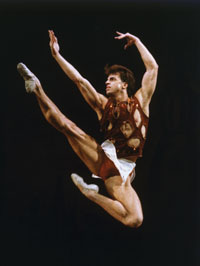
Choreography: George Balanchine
Music: Serge Prokofiev
George Balanchine’s Prodigal Son was first performed by Diaghilev’s Ballets Russes in Paris on May 21, 1929 and was an instant success. The remarkable coming-together of music, dance and design was the product of the collaborative talents of Prokofiev, Rouault and Balanchine, modern masters of their respective arts. Composer Serge Prokofiev’s vigorous and moving score, and painter George Rouault’s bold lines and jeweled tones for set and costumes are, now as then, essential to the whole. The work as performed by the State Ballet of Missouri more than half a century later, is largely intact.
Prodigal was the last work choreographed by Balanchine for the Ballets Russes before Diaghilev’s death. A ballet based on the Biblical tale had been suggested by Diaghilev’s assistant, Boris Kochno. Infused with rigors of Russian character (i.e. folk) dance, acrobatics, and mechanistic imagery, the ballet shares with the Bible only the broadest outlines. In the color filling those lines, the work takes on its extraordinary tone. The story suited Balanchine and he wrote: ” I think it is one of the best of all ballet libretti. It is simplicity itself, in the form of A, B, and the A again. It is the story of someone who has everything again. It seemed relatively simple to portray the roles of the father and son: on one could mistake the identity. The story of the older son was not interesting for the dance and we wisely omitted it from the ballet.”
Into the second scene scuttle the “Drinking Companions.” Variously described as monstrous crabs, devouring insects, or fiendish machines, their movements at times suggest a debauched slapstick, at others a version of the stylized theatrical Constructivism of the period. With the coiling hypnotic Siren, Balanchine has created a dance of fascination and revulsion incorporating highly developed technique and acrobatics, Marilyn Hunt wrote in Dance Chronicle that it sent “a call which would echo down the years in the repertoire Balanchine created for his women: familiar mock-elegant gestures, passionate twinings, lethal extremities.” In the last scene the ballet’s conclusion hangs on mime and music, on the dancer’s dramatic capability and Prokofiev’s profoundly affecting score.
The ballet was introduced into the repertoire of the New York City Ballet in 1950 and is now generally considered a true classic work. It was premiered by Stare Ballet of Missouri in the fall of 1986.
